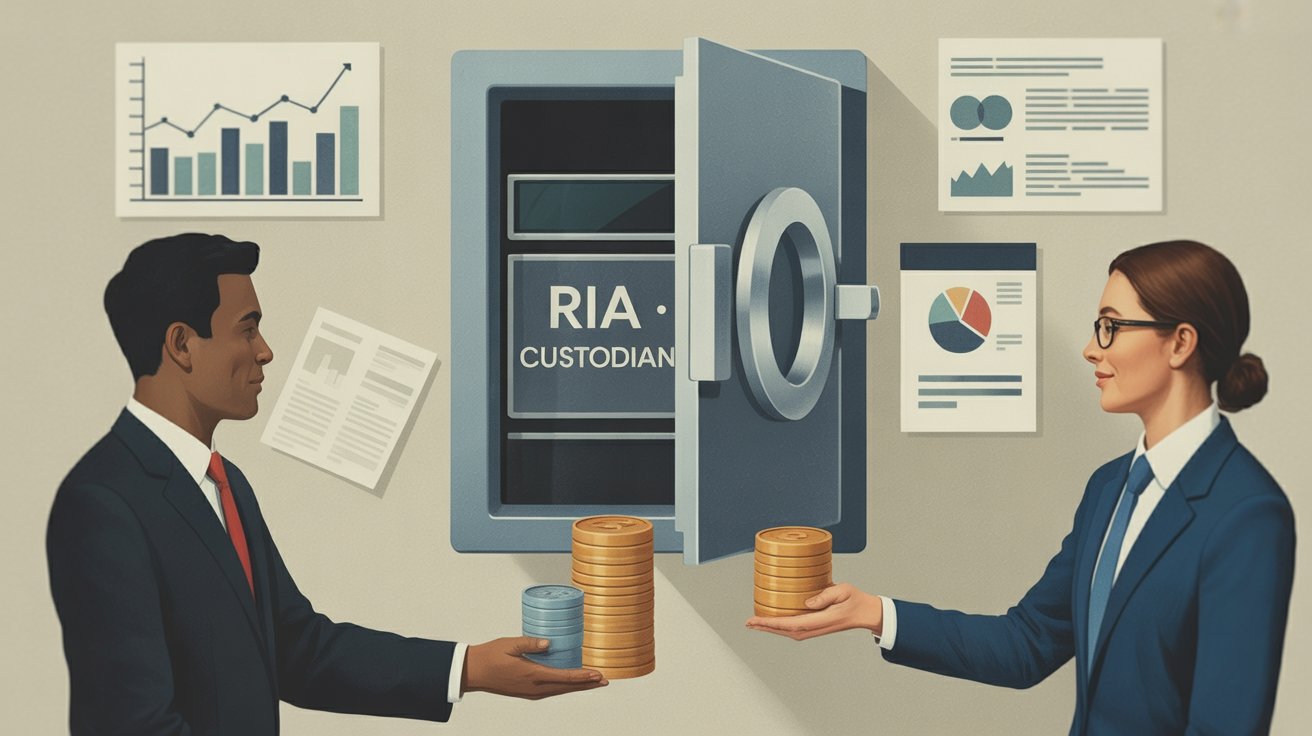You're finally launching your RIA. You've filed the paperwork, built your investment philosophy, and maybe even landed your first few clients. But then reality hits – where exactly are you going to hold all that client money? The answer might seem obvious until you start digging into the actual mechanics of RIA custody. Suddenly you're faced with dozens of options, each claiming to be the best choice for your specific situation.
Charles Schwab now serves well over half of all RIA firms after acquiring TD Ameritrade. Meanwhile, newcomers like Altruist have seen their RIA client base more than double (111.7% growth year-over-year) as advisors hunt for modern platforms that actually work the way they want them to.
The truth is, your custodian choice will probably affect your business more than any other vendor relationship. It touches everything from daily workflow and client experience to your bottom line. And with 15,396 SEC-registered advisory firms managing $128.4 trillion in client assets as of 2023, the competition among custodians has never been fiercer.
So how do you actually choose? What makes one custodian better than another for your specific practice? We'll walk through everything you need to know about RIA custody, from the regulatory requirements to the practical considerations that matter day-to-day.
The Role of an RIA Custodian
Let's start with the basics. By law, specifically the Investment Advisers Act of 1940 enforced by regulatory agencies, RIAs must entrust client funds and securities to a 'qualified custodian' rather than hold assets directly. This rule exists to protect investors from fraud and misuse of their assets. The custodian holds everything in secure accounts, usually under the client's name or clearly segregated for their benefit. The primary role is safeguarding client assets from unauthorized access, fraud, or misuse.
But custodians do way more than just hold money. Most execute and clear trades as instructed by the advisor, handle cash movements, and maintain records. They're basically the administrative backbone of your advisory relationship. You make the investment decisions, they make sure everything gets processed correctly and stays secure.
What is RIA Custodianship?
RIA custodianship refers to the system of having an independent financial institution hold and administer client assets on behalf of an RIA. Under SEC rules, an advisor cannot take physical custody of client assets. When you invest money with an RIA, your stocks, bonds, or cash will actually be held in an account at a custodian like Schwab or Fidelity, in your name. The RIA can trade and manage the assets, but they can't access them for any other purpose.
This arrangement creates what you might call a system of checks and balances. The advisor guides the strategy, but the custodian holds the purse strings, making sure assets remain secure and only move with proper authorization. Every year, custodians are subject to surprise audits to verify they are properly segregating and safeguarding assets.
Functions of RIA Custodians
A good RIA custodian provides a comprehensive suite of services that enable advisory firms to serve clients efficiently. Secure custody of assets is obviously the foundation. The custodian handles the daily safekeeping of stocks, bonds, funds, and alternative assets.
Transaction execution and settlement is where you'll interact with your custodian most often. When you want to buy or sell securities, the custodian handles trade clearance, movement of funds, and delivery of securities. They also process corporate actions like dividend payments or stock splits into client accounts.
Most custodians offer broad investment product access, including thousands of mutual funds, ETFs, stocks, bonds, options, and even some alternative investments. Account administration and reporting covers all the back-office paperwork. This includes collecting and posting dividends and interest, processing deposits and withdrawals, providing periodic account statements and tax reports.
Compliance and oversight support helps ensure accounts get managed according to regulations. Many custodians also provide advisor technology and client interface solutions. Some even provide CRM systems or performance reporting software to their RIA clients.
Importance of Custody in Investment Advisory

Custody is often called the cornerstone of an advisory firm's operations. By using an independent custodian, an RIA assures clients that their wealth is held securely separate from the advisor's business. This drastically reduces the risk of fraud or theft. The Bernie Madoff scandal, for example, was enabled by the lack of an independent custodian to verify assets. More recently, high-profile failures like FTX have reinforced why custody rules are important.
From a client perspective, custody provides transparency and peace of mind. Clients receive independent statements and online access directly from the custodian, so they can always verify their account balances and holdings. For advisors, a reliable custodian allows them to focus on advice and portfolio management instead of worrying about trade settlement or record-keeping.
Choosing an RIA Custodian

Given its importance, choosing the right custodian is probably one of the most impactful decisions an RIA firm will make. Many advisors immediately think of the big names: for firms with a certain scale (often at least $100 million in AUM or more), the default options are often the "Big Three" of RIA custody: Schwab, Fidelity, or Pershing.
But one size doesn't fit all. If your RIA doesn't meet the asset minimums or target client profile of the mega-custodians, there are dozens of other custodial providers that cater to firms of varying sizes and specializations.
Key Factors to Consider
Selecting a custodian requires balancing multiple considerations. Here are four key factors advisors should weigh.
Reputation and experience matter enormously. You're effectively outsourcing the protection of client assets, so you want a partner with a strong reputation, financial stability, and a history of working with firms like yours. A well-regarded custodian can boost client confidence, especially during transitions.
Technology and innovation have become absolutely important in today's environment. Look for integrated, efficient tech and custodians that continually invest in updates like digital account opening, API integrations, and AI capabilities. A custodian stuck on legacy systems can seriously impede your firm's efficiency.
Cost and minimum asset requirements can be complex. Many RIA custodians market "free" trading or zero commissions, but there may be account maintenance fees, ticket charges on certain securities, markups on cash sweeps, or platform fees. Also, some custodians require a minimum level of assets (ranging from $10 million up to $100 million) before they will onboard an RIA firm.
Service and support can make or break your experience. Customer service quality, operational assistance, and the availability of additional practice management resources differ widely by custodian. Investment options and capabilities matter if you have specific client needs. An "open architecture" custodian will allow access to a huge range of investments without proprietary limitations.
Evaluating the Right RIA Custodian for Your Firm

Every advisory firm is unique, and the "right" custodian choice often depends on your firm's size, clientele, and growth strategy. Your firm size and AUM can determine what custodians are even available. For example, a big custodian might prefer firms with around $50 million+ in assets and many won't onboard a brand-new RIA with only a few million under management. Altruist's early growth was driven by its ability to attract newer RIAs that couldn't meet big custodians' asset minimums.
If you are a large RIA (over $1 billion AUM) or cater to ultra-high-net-worth clients, you might evaluate institutional scale custodians such as J.P. Morgan or Northern Trust that specialize in complex asset custody, banking integration, and high-touch service for big firms.
Consider where your firm is heading too. If you plan to double in size or add new services, make sure your custodian can accommodate that growth. Many TD Ameritrade advisors maintained a secondary custodian relationship during the Schwab acquisition transition. Flexibility can be a strategic asset.
Best Practices for Selection
Choosing a custodian is a major decision, but RIAs can approach it systematically. Do thorough due diligence. Treat selecting a custodian like hiring a key employee or choosing a major software platform. Apply structured criteria, not just gut feel. Use a structured scorecard and rate each custodian on factors like reputation, tech, cost, support, and fit for your niche.
A strong reputation and familiarity in your client segment can smooth client conversations during transitions. Consider a backup custodian strategy. Nearly 30% of RIAs now use two or more custodians. Why? It can be a defensive move – if one custodian has a tech outage or service issue, you have an alternative.
Don't assume the initially quoted fees or terms are set in stone. Also, carefully review the custodian's contract, paying attention to clauses about termination, record ownership, and any fine print on fees. If you are moving from one custodian to another, treat it as a project. Work closely with the new custodian's transition team to map out the account transfer process.
Types of RIA Custodians
The RIA custody world encompasses several types of institutions, all of which can serve as "qualified custodians" under SEC rules. Retail broker-dealer custodians are the household-name brokerage firms that offer custodial services to independent advisors. Bank and trust company custodians include institutions like BNY Mellon's Pershing Advisor Solutions, J.P. Morgan Custody, Northern Trust, and U.S. Bank.
Independent/regional broker-dealer platforms like LPL Financial provide custody to their affiliated RIAs or to external RIAs. Fintech/new entrant custodians have entered the market in recent years. Altruist, TradePMR, Axos Advisor Services, and others differentiate on modern technology, simplified pricing, and a service approach geared to smaller independent firms. Specialty custodians focus on particular asset types.
Entities that can be RIA custodians include banks, savings associations, trust companies, registered broker-dealers, registered futures commission merchants, or certain foreign financial institutions that segregate assets properly. Market power is heavily concentrated though. Just a handful of companies dominate RIA custody by assets. As of 2023, the top four custodians – Charles Schwab, Fidelity, Pershing, and LPL Financial – collectively hold about 84% of all RIA assets custodied in the U.S.

Overview of the Largest RIAs (Custodians)
By assets under custody, the leaders are clear. Charles Schwab, Fidelity, Pershing, and LPL are the top four by RIA custodial assets. Schwab is by far number one: post-merger, Schwab Advisor Services is custodian for around $3+ trillion in RIA assets. Fidelity is second with around $1.5 trillion, Pershing is third ($350 billion), and LPL Financial is fourth (~$194 billion).
Schwab serves over 13,000+ advisory firms (out of around 23,000 total SEC RIAs), meaning over half of all RIAs count Schwab as a custodian. Altruist, which launched only in 2019, announced it had over 4,200 advisors on its platform by late 2024 – making it the 3rd-largest RIA custodian by number of advisors.
Schwab's acquisition of TD Ameritrade turned the "Big Four" into a "Big Three." By retaining roughly 97-98% of TD's RIA clients, Schwab solidified an impressive market share. Custodians like J.P. Morgan, SSG, Fidelity, and Altruist saw the largest net increases in RIA clients over a one-year period.
Comparing Altruist and Other Custodians
How does a newcomer like Altruist stack up against established custodians? Altruist was built as a modern, all-in-one custodial platform. When it launched, it set itself apart by offering features like fully digital account opening, robo-style automated rebalancing, and built-in performance reporting all integrated at no additional cost.
Traditionally, an RIA using Schwab or Fidelity might use third-party software for rebalancing or reporting and pay thousands for it, whereas Altruist bundled those capabilities. The result is a slicker, more unified experience. Legacy custodians often face inertia from decades-old infrastructure. Some incumbent platforms still require multiple systems or manual steps for tasks that Altruist automated from scratch.
Altruist's value proposition includes radically transparent, low pricing for custody. It charges no custody platform fee, no trading commissions on standard securities, and even offers the first 100 accounts managed on its platform free. Traditional custodians appear free on the surface but generate revenue behind the scenes through cash sweep spreads, fund 12b-1 fees, ticket charges on certain products, and payment for order flow on trade executions.
Altruist reportedly crossed the $6 billion AUM mark after acquiring SSG and has been climbing since. Schwab, by comparison, manages trillions. Altruist has been especially successful with newly-formed RIAs and breakaways who are attracted to its easy onboarding and cost savings.
Schwab and Fidelity have been around for decades and integrate with virtually every major portfolio management, CRM, or financial planning software. Altruist's method is to reduce the need for third-party software by including most functionalities in-house. For firms that appreciate an all-in-one system, that's great. But for firms that already love certain software, Altruist's integrations are currently more limited.
Altruist markets itself as serving only RIAs, so every support rep is trained on RIA issues and when you call, you're supposed to get a human quickly. Other custodians like Interactive Brokers highlight a similar point: they have no proprietary advisory teams or in-house products that conflict with RIA clients.
Altruist vs. incumbent is a trade-off of innovation and focus vs. scale and established capabilities. Altruist offers a fresh experience: cutting-edge tech, transparent low costs, and an RIA-focused approach. The traditional custodians offer proven stability, vast integration networks, and the confidence of size. For now, the choice often comes down to your firm's priorities: if you value a streamlined, modern platform and are smaller or fee-conscious, Altruist is a strong contender. If you manage billions and need extensive features or simply value the assurance of a decades-old platform, a Schwab/Fidelity/Pershing might remain your go-to.
Final Thoughts
Choosing the right RIA custodian can feel overwhelming, but it doesn't have to be. The key is to know your firm's specific needs and matching them to what each custodian actually offers, not just their marketing promises. Whether you're a solo advisor getting started or managing billions for ultra-high-net-worth clients, there's probably a custodian built for your situation.
The world of RIA custody is changing fast. New players are pushing innovation while established giants are defending their territory with improved platforms and competitive pricing. As an advisor, you actually benefit from this competition through better technology, more transparent pricing, and improved service.
But here's something that often gets overlooked in all the custodian comparisons: compliance. Every marketing piece you create, every client communication you send, every website update you make needs to meet RIA compliance requirements. While you're focused on choosing the right custodian for operations, you also need systems that keep your marketing compliant with SEC and FINRA guidelines. Following a comprehensive RIA compliance manual can help ensure you're meeting all regulatory requirements.
That's where we come in. Luthor automatically reviews your marketing assets for compliance, catching potential regulatory issues before they become problems. Our AI engine updates in real time based on current guidelines, flagging non-compliant language and providing recommended fixes. All changes and decisions get logged, giving you a clear audit trail and reducing manual review overhead.
You can reduce the risk, effort, and time to tackle marketing compliance at scale with Luthor. We don't replace your compliance teams – we act as a force multiplier, automating repetitive tasks so your professionals can focus on higher-value work.
Ready to see how much time and effort Luthor can save your team? Request demo access and experience firsthand how automated compliance review can streamline your marketing workflow while keeping you on the right side of regulations.



.jpeg)
